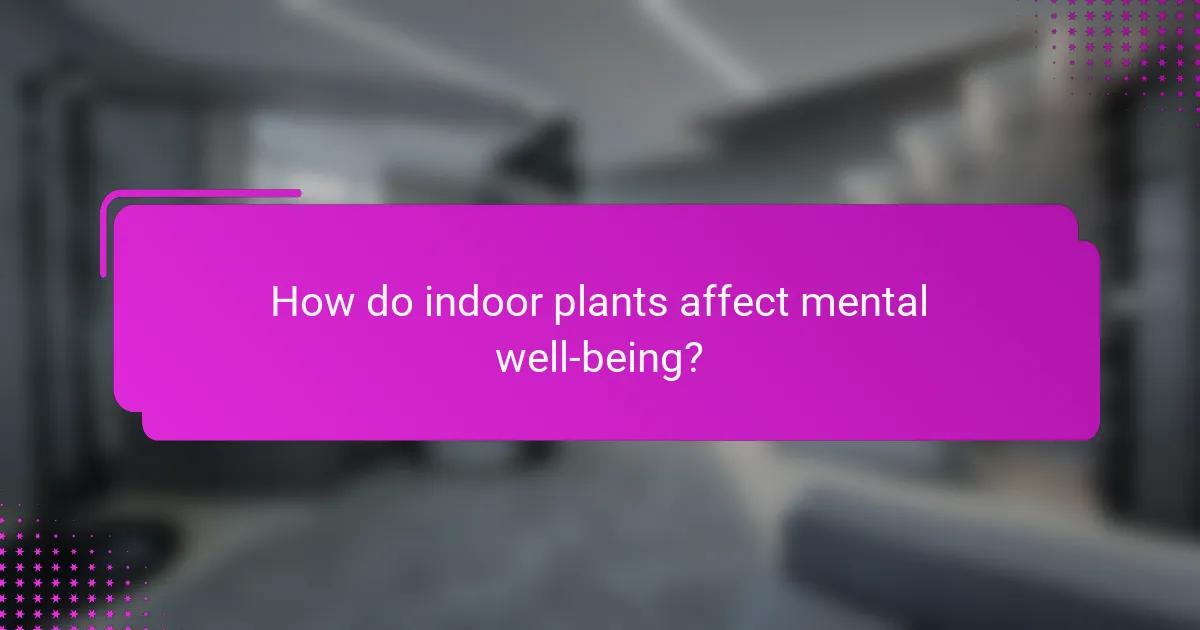Indoor plants not only improve air quality by filtering pollutants and increasing oxygen levels, but they also add aesthetic appeal to any space. By incorporating greenery into your home, you can create a vibrant and inviting atmosphere while enjoying the numerous health benefits they provide. Proper maintenance is key to ensuring these plants thrive, requiring attention to their specific needs for water, light, and soil.

How do indoor plants improve air quality?
Indoor plants enhance air quality by filtering pollutants and increasing oxygen levels. They absorb carbon dioxide and release oxygen through photosynthesis, contributing to a healthier indoor environment.
Reduction of indoor pollutants
Indoor plants can effectively reduce common pollutants such as formaldehyde, benzene, and trichloroethylene. These substances often originate from household items like cleaning products, paints, and furniture. By absorbing these toxins, plants help create a cleaner atmosphere.
To maximize pollutant reduction, consider placing multiple plants in a room, as different species target various contaminants. A diverse selection can lead to a more significant overall impact on indoor air quality.
Increased oxygen levels
Plants contribute to increased oxygen levels through the process of photosynthesis, where they convert carbon dioxide into oxygen. This process not only enhances air quality but also promotes a sense of well-being. A well-ventilated room with several plants can see a noticeable improvement in oxygen levels.
For optimal oxygen production, choose plants that are known for their efficiency, such as snake plants or peace lilies, which can thrive in low light and still produce substantial oxygen.
Specific plants for air purification
Some plants are particularly effective at purifying indoor air. Notable examples include spider plants, pothos, and rubber plants. These species are known for their ability to remove harmful toxins while being relatively easy to care for.
When selecting plants, consider their light and water requirements to ensure they thrive in your home environment. Grouping plants with similar needs can simplify maintenance and enhance their air-purifying effects.
NASA Clean Air Study findings
The NASA Clean Air Study identified several plants that can significantly improve indoor air quality. This research highlighted that certain species, like the Boston fern and the bamboo palm, can remove up to 87% of indoor air pollutants in 24 hours.
Using the findings from this study, homeowners can strategically select plants that not only beautify their space but also contribute to a healthier living environment. Incorporating these plants into your home can lead to noticeable improvements in air quality over time.

What are the aesthetic benefits of indoor plants?
Indoor plants enhance the aesthetic appeal of living spaces by adding color, texture, and life. They can transform a dull room into a vibrant environment, making it more inviting and enjoyable.
Enhancement of interior design
Indoor plants serve as natural decor elements that complement various interior design styles, from modern to rustic. They can act as focal points or subtle accents, depending on their placement and size. Incorporating plants into your decor can soften hard lines and add warmth to a space.
Consider using larger plants, like fiddle leaf figs or rubber plants, in open areas to create a striking visual impact. Smaller plants, such as succulents or ferns, work well on shelves or desks for a touch of greenery without overwhelming the space.
Variety of plant species for decor
The diversity of indoor plant species allows for endless design possibilities. From leafy greens to flowering varieties, you can choose plants that fit your aesthetic preferences and care capabilities. Popular options include snake plants, pothos, and peace lilies, each offering unique shapes and colors.
Mixing different species can create a dynamic display, but it’s essential to consider their light and water requirements to ensure they thrive together. Grouping plants with similar needs can simplify maintenance while enhancing visual interest.
Seasonal plant choices
Seasonal plants can refresh your indoor decor throughout the year. In spring and summer, consider vibrant flowering plants like geraniums or orchids to bring color indoors. During fall and winter, opt for evergreens or holiday-themed plants like poinsettias to maintain a festive atmosphere.
Rotating plants seasonally not only keeps your space looking fresh but also allows you to explore different care routines and plant types. Be mindful of local climate conditions when selecting seasonal plants to ensure they adapt well to your indoor environment.

How to maintain indoor plants effectively?
Maintaining indoor plants effectively involves understanding their specific needs for water, light, and soil. By following a consistent care routine, you can ensure your plants thrive and enhance your indoor environment.
Watering schedules
Establishing a proper watering schedule is crucial for indoor plant health. Most indoor plants prefer to dry out slightly between waterings, so check the top inch of soil; if it’s dry, it’s time to water. Generally, watering once a week is a good starting point, but this can vary based on plant type, pot size, and humidity levels.
Overwatering is a common mistake, leading to root rot. To avoid this, ensure pots have drainage holes and consider using a moisture meter for more precise watering needs.
Optimal lighting conditions
Indoor plants require varying amounts of light depending on their species. Most thrive in bright, indirect sunlight, while some can tolerate low-light conditions. Position your plants near windows but avoid direct sunlight, which can scorch leaves.
To determine the best lighting for your plants, observe their growth patterns. If they become leggy or the leaves turn yellow, they may need more light. Conversely, if leaves are browning, they might be getting too much sun.
Soil and fertilization tips
Choosing the right soil is essential for indoor plants. A well-draining potting mix is typically ideal, as it retains moisture without becoming waterlogged. Consider using a mix designed for your specific plant type, such as cactus mix for succulents or orchid mix for epiphytic plants.
Fertilization should be done during the growing season, usually spring and summer. Use a balanced, water-soluble fertilizer every 4-6 weeks, but reduce or stop feeding in fall and winter when most plants enter dormancy. Always follow the manufacturer’s instructions to avoid over-fertilizing, which can harm your plants.

What are the best indoor plants for beginners?
For beginners, the best indoor plants are those that require minimal care and thrive in various conditions. Snake plants, pothos, and spider plants are excellent choices due to their resilience and air-purifying qualities.
Snake plant
Snake plants, also known as Sansevieria, are ideal for beginners due to their hardiness. They can tolerate low light and infrequent watering, making them perfect for busy lifestyles.
These plants have striking, upright leaves that can grow up to several feet tall. They are also known for their air-purifying abilities, removing toxins like formaldehyde and benzene from indoor air.
Pothos
Pothos, or Epipremnum aureum, is another great option for novice plant owners. This vine is adaptable to various lighting conditions, though it prefers indirect light, and requires watering only when the soil is dry.
With its heart-shaped leaves and trailing growth, pothos adds a lush aesthetic to any space. It can be easily propagated by cuttings, allowing you to expand your indoor garden effortlessly.
Spider plant
Spider plants, or Chlorophytum comosum, are well-suited for beginners and are known for their air-purifying properties. They thrive in bright, indirect sunlight and can tolerate occasional neglect in watering.
These plants produce “baby” spiderettes that can be replanted, making them a fun choice for propagation. Their arching leaves and unique appearance make them a popular decorative choice for homes and offices alike.

How do indoor plants affect mental well-being?
Indoor plants significantly enhance mental well-being by reducing stress and anxiety, boosting productivity, and fostering a connection to nature. Their presence can create a calming environment that promotes emotional health and cognitive function.
Reduction of stress and anxiety
Indoor plants help lower stress and anxiety levels by providing a soothing atmosphere. Research suggests that interacting with plants can decrease cortisol levels, a hormone linked to stress. Simply being around greenery can evoke feelings of tranquility and relaxation.
To maximize these benefits, consider placing plants in areas where you spend the most time, such as your living room or workspace. Low-maintenance options like snake plants or peace lilies can be ideal choices for beginners.
Boost in productivity
Having indoor plants can lead to a noticeable boost in productivity. Studies indicate that the presence of plants in workspaces can enhance focus and creativity, leading to better performance on tasks. A well-vegetated environment can improve air quality, which also contributes to increased cognitive function.
To harness this productivity boost, incorporate plants like pothos or spider plants into your office setup. Aim for a mix of greenery that requires minimal care but still adds visual appeal.
Connection to nature indoors
Indoor plants create a vital connection to nature, which is often lacking in urban environments. This connection can improve overall mood and mental clarity, making spaces feel more inviting and less sterile. Natural elements in your home can evoke a sense of peace and well-being.
To enhance this connection, choose a variety of plants that thrive indoors, such as ferns or rubber plants. Consider arranging them in a way that mimics natural settings, which can further enrich your indoor experience.

What are the costs associated with indoor plants?
The costs associated with indoor plants can be divided into initial purchase costs and ongoing maintenance expenses. Understanding these costs helps in budgeting and ensuring the long-term health of your plants.
Initial purchase costs
Initial purchase costs for indoor plants vary widely depending on the type and size of the plant. Small, common varieties like pothos or snake plants may range from $10 to $30, while larger or rare species can cost anywhere from $50 to several hundred dollars.
When budgeting for initial costs, consider additional items such as pots, soil, and any necessary tools. A basic setup might add another $20 to $50 to your total expense.
Ongoing maintenance expenses
Ongoing maintenance expenses include water, fertilizer, and potential pest control. Monthly costs for these items can be relatively low, often totaling around $5 to $15, depending on the number of plants and their specific needs.
It’s also essential to factor in occasional repotting or replacing plants that do not thrive. Setting aside a small budget for these unexpected costs can help maintain your indoor garden effectively.


